Pool heat pump: selection criteria and installation rules
Heat pumps are, of course, one of the best inventions in the field of heating systems. It literally makes it possible to extract virtually free energy directly from the air, as well as from the earth or water. If you use a heat pump for the pool, the cost of heating the water can be significantly reduced.
We will tell you how to choose the best model for using “green” energy to generate heat to heat water. The article presented for familiarization sets out in detail the principle of the system. Here you will learn how to mount the unit, how to properly operate it in a domestic environment.
The content of the article:
How does such a pump work?
Energy is everywhere, even in those objects that seem extremely cold to us. It’s just that this energy has a low potential. Heat pumps allow you to extract it from the environment and convert it to energy with high potential. In this condition thermal energy can be used for heating.
Heat pumps, however, like refrigerators, operate on the Carnot principle. The refrigerator transfers thermal energy from the chamber to the surrounding space to create a cooling effect, then the heat pump works in the opposite direction.
Such a system consists of two main parts - external and internal, between them are a compressor and an evaporator. So, the coolant circulates through a system of pipes that are located outside. At the same time, it absorbs energy dispersed in the bulk of the earth, in water or in air, depending on the type of pump.
Then, the coolant passes through the chamber of the evaporator filled with refrigerant (usually freon). The refrigerant boils at a very low temperature. Heated upon contact with thermal energy of low potential, it goes into a gaseous state and enters the compressor.
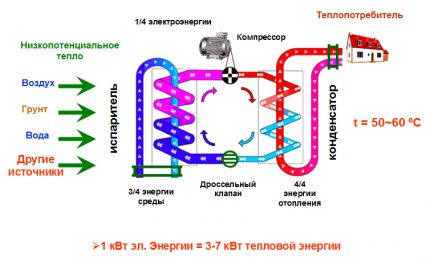
Here the gas warms up and moves to the condenser. Then the refrigerant cools, again returning to the liquid state, and the heat that it has collected enters the internal heating system, i.e. on the heating system of the house or, in this case, the pool. The cycle repeats many times.
Of course, for the operation of such a system, namely pumping units, a certain amount of electricity will be needed, without access to which the system will not be able to work.
But the amount of electricity needed for a heat pump is about four times less than the cost of directly heating water with an electric heater. With a consumption of less than 2.5 kW of power for electricity, the heat pump can generate more than 10 kW of thermal energy.
How to choose a suitable system?
The design features of the heat pump make it more resistant to high humidity than any other water heating system. But you need to choose the right one heat pump type, i.e. determine the source of low-grade thermal energy.
The more stable the temperature of the medium, the more efficient the heat pump. The Earth is considered in this respect the best option, but practical implementation requires the fulfillment of a number of difficult conditions.
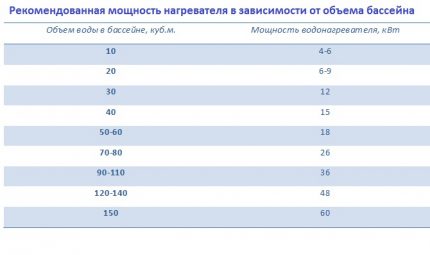
It will take a spacious plot of land and large-scale earthwork. Pipes through which water circulates will have to be placed in the thickness of the soil, to fulfill this requirement is not always possible and convenient. Ground-to-water heat pumps are rarely used for pools.
It is a little easier to arrange a water heat pump, since water is used as an energy source. The best option is a nearby water body: a pond, lake, river, etc.
Not all landowners have access to such resources. A more affordable solution to the problem is to lower the water pipes into the well or well. This means that the site may have to build an additional source of water.
Less time and effort will be needed to install a heat pump that consumes energy dissipated in the air masses. To organize intensive air exchange, powerful fans are used. Neither will it be necessary to lay pipes in the ground or to drill a new well.
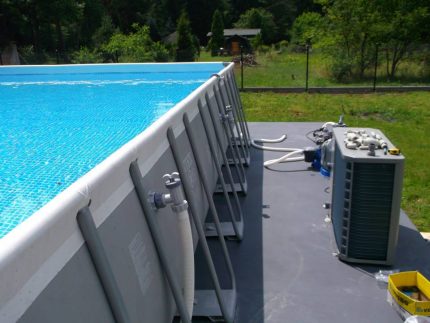
Of course, the efficiency of heating with an air heat pump can be slightly lower than when using stable energy sources such as land or water. However, for use during the season from spring to autumn, and not year-round, this model is ideal. Most of the pools in the sites are used during this period.
The heat pump can also be used in combination with other heating systems, for example, with electric heating. For heating a house, such models are sometimes combined with a gas or electric boiler. This is especially appropriate in areas with a harsh climate, since at temperatures below -20 degrees the efficiency of heat pumps is sharply reduced.
A feature of any industrial model of a heat pump is its high price. You can reduce costs if you build such a device yourself. This is not a very difficult task, many craftsmen have successfully dealt with it. But industrial models are more reliable, more efficient and easier to manage.
According to reviews, the high cost of an industrial model of a heat pump pays off in the first couple of years of operation, and sometimes in just a few months. At the same time, it is very important to choose a model whose power will exactly correspond to the heat needs of the object.
Thermal loss of the object
In order to choose the right heat pump according to its power, it is necessary to determine the heat loss of the pool in which the device will be installed.
In the case of the pool, you should consider:
- the place where the pool is located;
- availability and degree of reliability of the pool;
- bath bowl volume;
- initial water temperature;
- optimal bathing water temperature;
- the presence of additional factors affecting the change in water temperature: air heating in an indoor building, air conditioning, etc.
To calculate the heat loss of the structure, some experts recommend using the methodology described in DBN B.2.5-67: 2013. The pump capacity should be 30% higher than the heat loss in the pool.
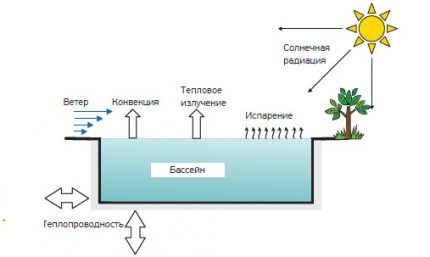
These calculations are quite specific, it is better to entrust them to a specialist. Useful recommendations can be obtained from experienced professionals who are involved in the manufacture or sale of heat pumps. Information on the capacity of the heat exchanger of the device will also be useful when choosing a heat pump.
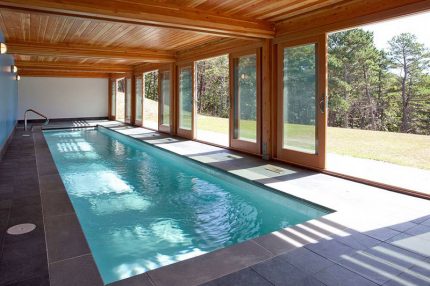
This indicator reflects the consumption of thermal energy for heating water in the pool for a certain period of time.
In a simplified form, the formula may look like:
P = 1.16 X ΔT / t X V (kW)
Where:
- 1.16 - correction coefficient of heat loss;
- ΔT - the number of degrees separating the initial and final indicator of the water temperature in the pool, ºС;
- t is the operating time of the device until the required water temperature is reached, hour;
- V is the volume of the bathing bowl, cubic m
Of course, this formula does not take into account a number of factors such as the effect of heating in the indoor pool, the presence of air conditioning, the presence of insulation, etc.
But when choosing the right heat pump model, such a calculation can be very useful.In the course of calculations, it is useful to take into account that the optimum temperature for an indoor pool is considered to be an air temperature of 28 degrees, and a water temperature of 24 degrees.
Important points when choosing a pump
When choosing a suitable heat pump, you should focus not only on its power. Other factors are also important. For example, these are the dimensions of a pump resembling a large metal box.
The installation site is usually chosen in advance, you should make sure that the selected model fits freely there, while leaving enough space for the person who will install and maintain the device.
The smaller the difference between the temperature of the air outside and the temperature of the water in the pool, the more effect the use of the heat pump will give, and the higher its productivity.
The automatic control of some models allows you to change the operation of the pump, taking into account not only the outside temperature, but also the rate of water cooling in the pool, as well as the building's ability (if we are talking about an indoor pool) to keep heat.
During operation, the heat pump vibrates and makes noise. The less noise on the site, the better. Before buying, you should find a way to assess the noise level that various heat pump models emit.
The cost of the unit can be significantly affected by the presence of an automatic control unit. If funds allow, do not give up on this modern and convenient addition. Firstly, automation increases comfort during the use of equipment, since you do not have to constantly be distracted to turn it on, adjust, turn it off, etc.
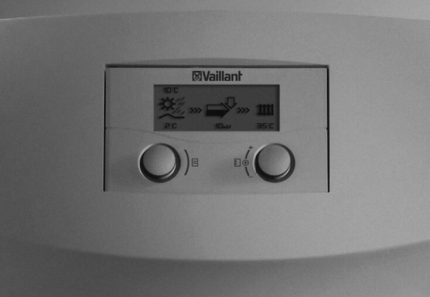
Secondly, the operation of the device in automatic mode significantly increases the resource of its operation, i.e. lifetime. But damage is still possible. To minimize the problems associated with the operation of the heat pump, the availability of correctly executed documents for warranty service of the device will help.
However, the presence of an official form with a seal is not enough. Sometimes sellers are modestly silent about the fact that warranty repairs are carried out only by a specialized enterprise, which is located a hundred kilometers from the installation site.
It also happened that the device had to be sent abroad for repair. Such warranty service is extremely inconvenient, since it takes the owner whole months of time.
Craftsmen who can easily repair household appliances can study the features of the device of the selected model and access to spare parts in advance. If the necessary parts are not available somewhere nearby, you will have to specially order them, pay for long delivery, etc. prudence will help to avoid such problems.
If the cost of a factory-made heat pump seems “sky-high" high, you can do it yourself. How an aggregate is constructed from practically waste initial materials is described in the article recommended by us.
Features of mounting the device
The procedure for connecting a heat pump for a pool depends on the characteristics of a particular model. Therefore, before starting work, you should carefully study the manufacturer's instructions and precisely comply with the requirements and recommendations set out in it. Usually, industrial models are delivered pre-assembled and with a set of components necessary for installation.
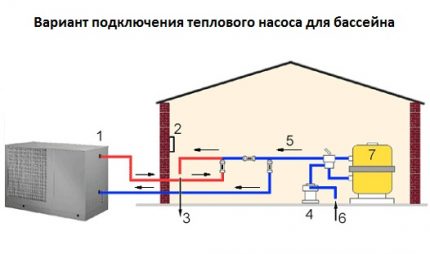
1 - Swimming pool heat pump
2 - Remote control device
3 - Clean water for the pool
4 - circulation pump
5 - Bypass (bypass) and control valves
6 - Pool water supply pipe
7 - Filter
During the connection, you will need to install a pair of pipes, as well as provide power. The heater is installed in the pool maintenance system so that it is located after the filtration system and in front of the chlorinator.
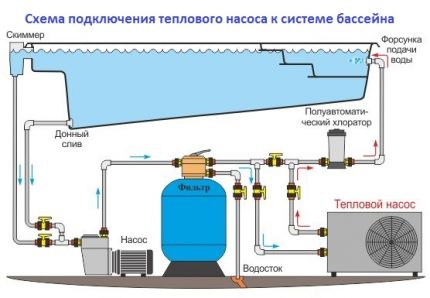
It is very important to choose the right place to install the equipment. Usually air-to-water heat pump It is an aggregate of impressive dimensions, reminiscent of the outdoor unit of an air conditioning split system.
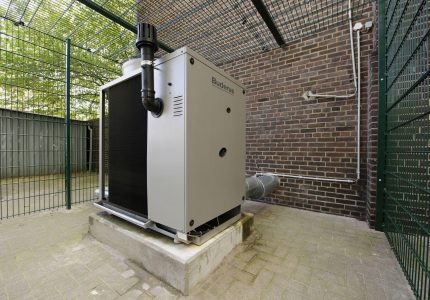
The place for installation of such equipment must meet the following requirements:
- good ventilation;
- lack of obstacles to the movement of air masses;
- remoteness from open flame and other sources of heat;
- protection against external environmental factors: precipitation, debris falling from above, etc .;
- Availability for maintenance and necessary repairs.
Most often, the heat pump is installed under a canopy. For added protection, you can install a pair of side walls, but they should not interfere with the airflow that is forced by the fans.
The pump is mounted on a metal frame, the base must be strictly horizontal. This will minimize such problems as vibration and noise during operation of the device, as well as protect the device from breakdowns.
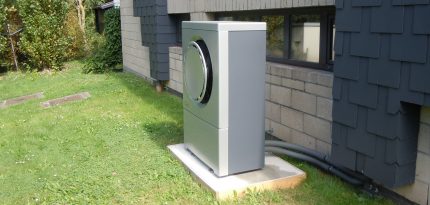
When installing the heat pump and connecting it to the system, it is important to make sure that all its elements are clean. It does not hurt to check the inner surface of the pipes with which the connection is made.
All pipe junctions through which water circulates must be carefully sealed and checked for leaks. To prevent vibration from the heat pump during its operation being transmitted to the rest of the system, it makes sense to consider the option of connecting using flexible hoses.
Particular attention will be required to provide power to the heat pump. It must fully comply with the rules for installing electrical equipment, taking into account all fire safety requirements.
Near the pool, a high level of humidity is usually maintained, and the likelihood of electrical contact with water increases significantly. Therefore, it is necessary to carefully insulate all places of electrical contacts, additionally protecting them from possible contact with moisture.
It is imperative that circuit breakers are included in the circuit for connecting the heat pump to the power supply, which are equipped with sensors that respond to temperature increases. Protective devices that prevent current leakage are also required.
All conductive nodes should be earthed without fail. To connect cables, both power and control, you will need special terminal blocks. The manufacturer's instructions usually indicate the required cross-section of the electrical cables through which you can connect the equipment to the power supply.
This data must be adhered to. The cable cross section may be more than recommended, but not less.
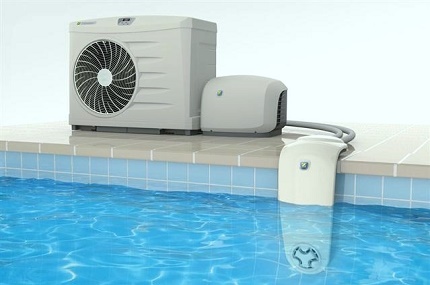
Homemade heat pump - is it real?
If you make a heat pump yourself, you can significantly save, but the effectiveness of such devices is slightly lower than that of industrial models. First, the individual elements of the pump are made, then they are connected to a common system. The evaporator can be made from a large plastic tank. A copper coil is installed inside.
To make a coil, a copper pipe can be carefully wound around a gas bottle or other suitable cylindrical object to give it the desired shape. In the same way they make another coil - for the evaporator. This element is placed inside another tank, this time a metal one, welding work is required.
The compressor is simply bought or removed from another device, for example, from a broken air conditioner. When these three devices are ready, they are connected to a common system. Then the compressor is charged with refrigerant. It remains to connect the evaporator to the fan, which pumps air, and the condenser to the pool water heating system.
Significantly more difficult in the device water-to-water heat pump. Its construction requires the presence of a river or natural reservoir near the site, if they are not there, then wells are drilled. However, if it is impossible to get energy from the air for technical reasons, this option will also be useful.
Conclusions and useful video on the topic
The practical experience of pool water heating using heat pumps is presented in the following video:
The principle of operation of an air heat pump is clearly demonstrated here:
This video provides a very detailed overview of the operation and design of the air-water heat pump model:
A heat pump is a convenient, efficient and environmentally friendly way to heat a pool. With proper operation, the cost of the model will pay off very quickly, and proper installation will significantly increase the life of the device.
Want to share useful information on the topic of an article? Maybe you know how to make a heat pump for arranging a private pool with your own hands? Please write comments in the block below, ask questions, share your opinion and thematic photos.

 How to choose a filter for the pool: types of units and the rules for the right choice
How to choose a filter for the pool: types of units and the rules for the right choice 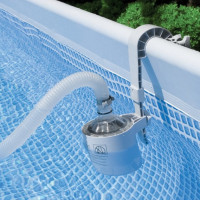 How to choose a pump for the pool: a comparative overview of different types of units
How to choose a pump for the pool: a comparative overview of different types of units 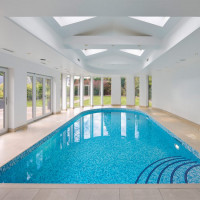 Organization of ventilation of the pool: the best methods of organizing air exchange
Organization of ventilation of the pool: the best methods of organizing air exchange 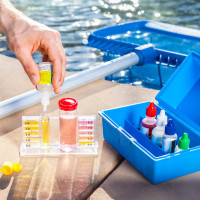 Coagulants for water purification in the pool: how to choose + application rules
Coagulants for water purification in the pool: how to choose + application rules 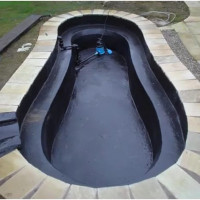 Do-it-yourself pool waterproofing: technology overview + step-by-step example of work
Do-it-yourself pool waterproofing: technology overview + step-by-step example of work  How to make a fountain pump yourself: a step-by-step workshop
How to make a fountain pump yourself: a step-by-step workshop  How much does it cost to connect gas to a private house: the price of organizing gas supply
How much does it cost to connect gas to a private house: the price of organizing gas supply  The best washing machines with dryer: model rating and customer tips
The best washing machines with dryer: model rating and customer tips  What is the color temperature of light and the nuances of choosing the temperature of the lamps to suit your needs
What is the color temperature of light and the nuances of choosing the temperature of the lamps to suit your needs  Replacement of a geyser in an apartment: replacement paperwork + basic norms and requirements
Replacement of a geyser in an apartment: replacement paperwork + basic norms and requirements
Well, I would advise, before installing a heat pump, to fully calculate the profitability of such a project. If you have access to main gas at an inexpensive rate, then in some cases it is much more profitable. Yes, the heat pump has environmental advantages, but do not forget about the high cost of both equipment and installation.Plus, the pump is equipped with a fairly noisy compressor, and this is an additional discomfort or noise isolation costs.
I considered the option of using an air heat pump to heat the cottage, but unlike geothermal and water thermal types, it has a direct dependence on the temperature outside the window. The lower the degree drops on the street, the lower the efficiency. It turns out that equipment wear is getting longer and the service life is shorter. This option is suitable only in spring and autumn, in winter it is still better to use gas or electricity for heating.